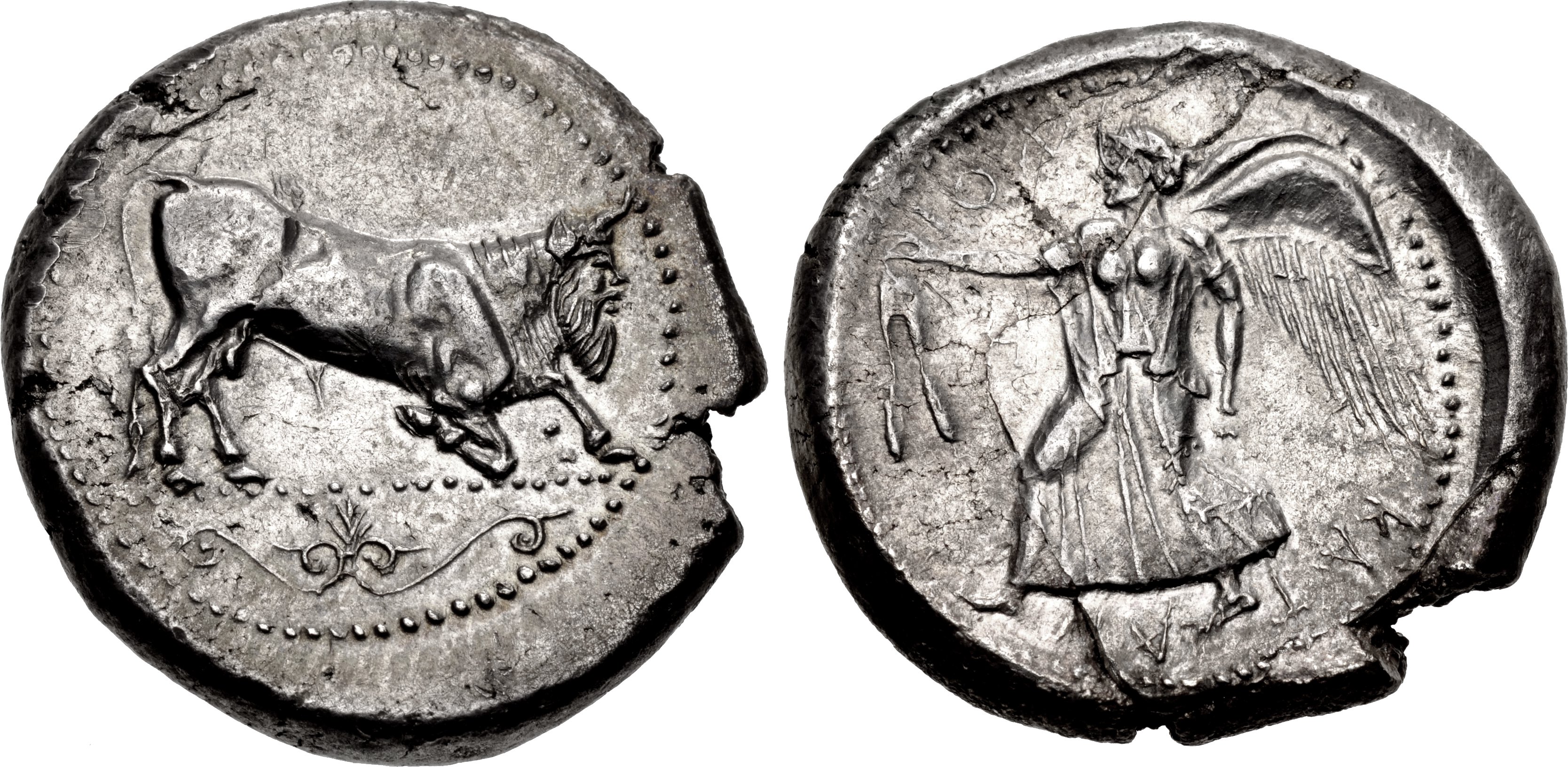450 BCE - 440 BCE | CEΛΑΣ
Overstriking coin
SO_137_-_Gela_(tetradrachm).jpg
Overstruck variety
Catana_HGC_2_565_.jpeg
[1]
|
|
Sale(s)Sale(s) ᵖ:
|
New York Sign. 3021, 06 Jan. 2013, 21470 ; Seaby Numismatic Bulletin, June 1966, A448.
|
| Private collection(s)Private collection(s) ᵖ:
|
Norman Davis collection
|
|
Description
| ObverseInscription or printing placed on the obverse.:
|
Charioteer driving quadriga right, holding kentron and reins. Above, Nike flying right, crowning the horses with wreath. In exergue, palmette with tendrils. Border of dots.
|
ReverseInscription or printing placed on the reverse.:
|
CEΛΑΣ (Greek) Forepart of man-headed bull (the river-god Gelas) to right.
|
Mint and issuing power
| MintIdentifies the place of manufacture or issue of a numismatic object.:
|
Gela
|
Ancient regionAncient region.
|
Sicily
|
Modern countryModern country: Italy
|
AuthorityIdentifies the issuing power. The authority can be "pretended" when the name or the portrait of X is on the coin but he/she was not the issuing power. It can also be "uncertain" when there is no mention of X on the coin but he/she was the issuing power according to the historical sources:
|
|
Chronology
| FromIdentifies the initial date in a range assigned in a numismatic context. 450 BCE toIdentifies the final date in a range assigned in a numismatic context.. 440 BCE
|
Classical 480-323 BC  periodTime period of the numismatic object. periodTime period of the numismatic object.
|
Physical description
MetalThe physical material (usually metal) from which an object is made.: Silver 
|
WeightWeight of the numismatic object (in grams). in grams: 17.2117.21 g <br />17,210 mg <br />
|
DenominationTerm indicating the value of a numismatic object. Examples: tetradrachm, chalkous, denarius.: tetradrachm 
|
AxisDescribes the directional relationship between the obverse and reverse of a numismatic object.: 77 mm <br />0.7 cm <br />
|
| DiameterDescribes diameter of an object (in mm).: 3232 mm <br />3.2 cm <br />
|
StandardStandard.: Attic
|
References
Description
| ObverseInscription or printing placed on the obverse.:
|
Bearded man-faced bull charging right. Palmette in exergue.
|
ReverseInscription or printing placed on the reverse.:
|
KATANAION (Greek) Nike advancing left, holding Tainan and wreath.
|
Mint and issuing power
| MintIdentifies the place of manufacture or issue of a numismatic object. ᵖ:
|
Catana
|
Ancient regionAncient region. ᵖ
|
Sicily
|
Modern countryModern country: Italy
|
AuthorityIdentifies the authority in whose name (explicitly or implicitly) a numismatic object was issued. ᵖ:
|
|
Chronology
| FromIdentifies the initial date in a range assigned in a numismatic context. 460 BCE toIdentifies the final date in a range assigned in a numismatic context.. 445 BCE
|
Classical 480-323 BC  periodTime period of the numismatic object. periodTime period of the numismatic object.
|
Physical description
| DenominationTerm indicating the value of a numismatic object. Examples: tetradrachm, chalkous, denarius. ᵖ:
|
tetradrachm 
|
StandardStandard. ᵖ:
|
Attic
|
References
References
- ^ Jenkins, Gilbert Kenneth (1970), The Coinage of Gela, AMUGS II, 2 vol., Berlin
- ^ Sylloge Nummorum Graecorum ANS 4. The Collection of the American Numismatic Society. Sicily 2 (Galaria - Styella), New York, 1977, 25 pl.
- a b Hoover, Oliver D. (2012), The Handbook of Greek Coinage Series. 2. Handbook of the Coins of Sicily (Including Lipara). Civic, Royal, Siculo-Punic, and Romano-Sicilian Issues. Sixth to First Centuries BC, Lancaster-London, 489 p.
- ^ SNG ANS 3 Sicily
- ^ Arniold-Biucchi, Carmen (1990), The Randazzo hoard 1980 and Sicilian chronology in the early fifth century B.C., Numismatic Studies 18, New York, 77 p., 20 pl.


